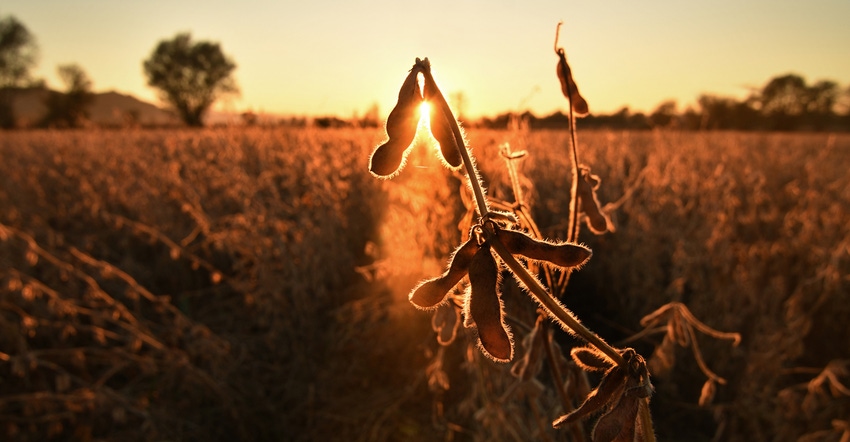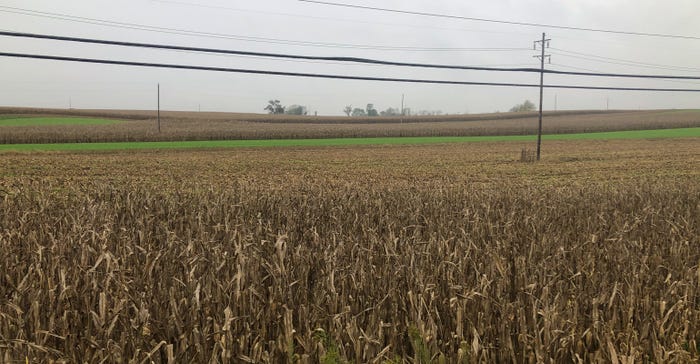
Rains from Tropical Storm Zeta were a welcome sight in many places. But left in its wake were temperatures that were anything but tropical.
Temperatures in many areas dipped into the mid to high 20s — especially Friday night into early Saturday morning — the coldest temps of the season thus far in major crop regions like south-central and southeastern Pennsylvania.
And there are still lots of corn and soybean acres yet to be harvested. If the corn has reached black layer, physiological maturity, then it should’ve gotten through the cold snap just fine, at least that’s the consensus from Extension agronomists. Double-crop soybeans, though, might need to be checked on.
Temperatures below 32 degrees F can damage soybean leaves, and temperatures below 30 degrees for an extended time can damage stems, pods and the seeds. A killing freeze is 28 degrees, but if the plant has reached maturity, the damage will be minimal.
David Holshouser, Extension agronomist from Virginia Cooperative Extension, has three possible field scenarios involving double-crop soybeans and the possible effects of this weekend’s cold snap on the crop.
Keep in mind that this is from 2013 and was written as a result of a widespread early frost in Virginia, but it could be useful in some places this season:
Freeze-damaged immature soybeans. These are soybeans in the R6 stage (green pods and seed) where a hard freeze kills the plant. We are likely well past this stage, even in the latest planted fields, but there might be some small pockets of this out there.
This is a “worst case scenario,” he says, and the result is a crop that won’t mature, leaving you with green seed that might not sell.
Frost-damaged immature soybeans. These are R6 soybeans where a frost damages many of the leaves on the plant.
Again, we’re likely well past this stage, but in this case the plants have not been killed and should continue to mature, though it will be delayed and drying time extended. There may be some green seed left, but more likely you’ll see smaller seeds.
Frost or freeze-damaged mature soybeans. These are soybeans that are physiologically mature — R7 stage, at least one pod on 50% of the plants has reached brown color — where the crop will mature but the seed will take a little longer to dry.
This is the most likely scenario many farmers are in right now, but the good news is that yields will most likely not be affected.
“If a frost occurred at the growth stage R7 or when one pod on the main stem reaches its mature pod color, beans should dry normally, and yield and quality should not be affected much,” according to a post by Zach Larson, Penn State Extension agronomist. “Additionally, it is unlikely that bean oil and protein content will be reduced. While mature pod color can vary between varieties, a good indicator are yellow-colored pods sprinkled with brown.
“A better check is to open pods and check for the separation of beans from the white membrane inside the pod.”
As far as harvesting, it's best to wait for the crop to continue drying down to avoid shatter loss, he says.
"If fields experienced a freeze throughout the entire canopy, is it best to harvest frost-damaged fields at moisture levels between 16% and 18% to avoid shatter loss," he says. "Extra attention should be paid to combine settings, too. If beans are at normal harvest moisture content, keep the cylinder speed to a minimum to avoid bean crackage. If beans are wetter than normal, reduce concave clearance first, then increase RPM until acceptable threshing occurs, making incremental adjustments and checking your progress after each adjustment.
"Electronic moisture meters are likely to underestimate the moisture levels in green and immature soybeans, so add 1.5 percentage points to moisture meter readings when testing mixtures of immature and mature beans and adjust drying times accordingly. Recheck the moisture content after drying and after a couple days to permit moisture equilibration.”
Heidi Reed, a Penn State Extension agronomist, says it might be better to just get the beans dried. “Regardless of maturity at the moment, pod shatter will also become a greater concern, and quality and harvest loss will increase with time as we see warming and cooling shrink-swell,” Reed says in an email. “Growers might potentially harvest a little higher moisture beans than normal and pay to dry as opposed to subjecting the crop to more loss the longer it stays in the field.”
A blog post from Iowa State University Extension delves deeper into the effects of freezing temperatures on late soybeans and to handle the crop.
Lots to harvest yet
About half of Pennsylvania’s corn crop has yet to be harvested. The most recent NASS Crop Progress Report shows 48% of the crop has been harvested. Soybeans are 75% harvested.
Meanwhile, in Maryland, the corn crop is 81% harvested while soybeans are only 36% harvested — much of this is likely double-crop beans. In Delaware, corn is 93% harvested while soybeans are 22% harvested.
 STILL LOTS OF CORN: According to the NASS Crop Progress Report, about half of the state’s corn crop has yet to be harvested, including on this farm in southern Lebanon County.
STILL LOTS OF CORN: According to the NASS Crop Progress Report, about half of the state’s corn crop has yet to be harvested, including on this farm in southern Lebanon County.

Depending on the location, much of New York state has already experienced a frost or freeze. None the less, only 23% of corn has been harvested with 75% of the crop now mature, according to NASS. Soybeans are 59% harvested.
Freeze damage to corn is not really a concern once it hits black layer, which is considered physiological maturity. Black layer forms at the tip of the kernels when the milk level has reached the two-thirds milk line — grain moisture is around 30%.
A killing freeze will bring photosynthesis to a halt and will stop dry matter accumulation, according to Bob Nielsen, professor of agronomy at Purdue University. This is what leads to yield loss, especially if corn hasn’t reached that crucial black layer. Here is a 2019 post by Nielsen that explains more.
A positive effect of the freeze, though, is that it will wipe out pesky summer annual weeds, according to Jeff Graybill, Penn State Extension agronomist. Weeds like pokeweed, burcucumber and others should be wiped out by the freeze.
For many growers, that’ll be a welcome sight.
About the Author(s)
You May Also Like






